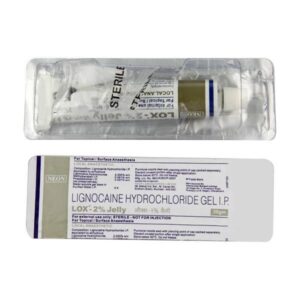LIGNOCAINE + ADRENALINE
Lignocaine: Lignocaine (also known as Lidocaine) is a medication that belongs to the class of drugs called local anesthetics. It is commonly used to numb a specific area of the body to relieve pain or discomfort during medical procedures or surgeries. It can also be used to treat irregular heart rhythms, as it has some antiarrhythmic properties.
The main mechanism of action of lignocaine is to block nerve signals in a specific area where it is applied or injected. By binding to and inhibiting voltage-gated sodium channels on the nerve cell membrane, lignocaine prevents the generation and conduction of nerve impulses, resulting in temporary numbness.
The dosage and application method of lignocaine can vary depending on the specific medical procedure and the individual’s condition. It is available in various forms, including injections, creams, ointments, and sprays.
Some common side effects of lignocaine include localized reactions such as redness, swelling, or itching at the site of application or injection. In rare cases, it may cause systemic effects such as dizziness, lightheadedness, nausea, vomiting, headache, or fatigue. If applied in high doses or absorbed into the bloodstream, lignocaine can cause more serious side effects like heart rhythm disturbances, seizures, or allergic reactions.
It is important to follow the recommended dosage and safety guidelines provided by healthcare professionals when using lignocaine, as misuse or excessive use can lead to serious complications. Lignocaine should also be used with caution in individuals who are allergic to local anesthetics or have certain medical conditions, such as heart, liver, or kidney problems.
Overall, lignocaine is a widely used local anesthetic medication that can effectively block nerves to provide pain relief during medical procedures. However, it should be used under the supervision of a healthcare professional to minimize the risk of side effects or complications.
Adrenaline: Adrenaline, also known as epinephrine, is a medication and hormone used in emergency situations to treat severe allergic reactions (anaphylaxis), cardiac arrest, and acute asthma attacks. It belongs to the class of medications called sympathomimetics.
It acts by stimulating alpha and beta-adrenergic receptors in the body. Activation of alpha receptors causes vasoconstriction, leading to increased blood pressure and reduced blood flow to the organs. Activation of beta receptors, on the other hand, results in bronchodilation, increased heart rate, and improved cardiac output.
Adrenaline is typically administered via injection, either intramuscularly or intravenously, depending on the indication. The recommended dose for anaphylaxis is 0.3 to 0.5 mg injected into the outer thigh. In cardiac arrest, 1 mg is given every 3-5 minutes via intravenous or endotracheal route.
Possible side effects of adrenaline include anxiety, tremors, palpitations, headache, dizziness, sweating, nausea, and vomiting. In rare cases, it can cause serious adverse effects such as irregular heart rhythm (arrhythmia), heart attack, high blood pressure, pulmonary edema, and cardiac arrest. Therefore, it should be used with caution and under the supervision of a healthcare professional.
It is worth noting that Adrenaline should only be used in emergency situations and as directed by a healthcare professional. It is not intended for routine use or as a long-term treatment for any condition.


